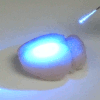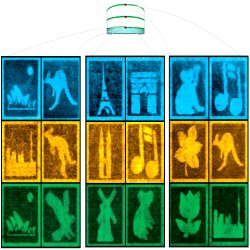-
Viewpoint on 'IONS'
Viewpoint on 'Scientific Literacy'
- Proudly sponsored by
-


-
Spooky Light

Many are afraid of darkness, but who gets spooked by light? Light has now been used to condition rats to fear, teaching us about fear memory formation.
-
Twisted Electrons

Recent experiments lend a brand new twist to the tale unfolding in the field of electron microscopy. Promising electron vortices have made their appearance at the crossroads between nanotechnology and magnetism.
-
Much More than a Contact Lens

Super contact lenses which display background information onto your real world view seem like a gadget taken from the latest Spielberg movie. Thanks to a recently developed technique, this scenario may soon be real.
Volume 6 Story 1 - 14/7/2009
The Five Dimensions
Can 300 DVDs be squeezed into a single optical disc? Ground breaking research in the field of surface plasmon physics seems to suggest so.

Our world is growing increasingly hungry for digital data storage space. Since the early days of floppy disks, technology has advanced rapidly, increasing our storage capabilities by orders of magnitude. Despite that, the demand for high density data storage has been growing ever faster. Developments in optical storage technology have opened up new avenues in recording and reading digital data. What will be the next technological breakthrough? Recently, researchers Peter Zijlstra, James W. M. Chon, and Min Gu from the Center of Micro-Photonics at Swinburne University in Australia have found a way to bring data storage into new dimensions.
Current optical storage media, such as CDs (Compact Discs) and DVDs (Digital Versatile Discs), store digital information on a plastic disk in the form of pits and flats. They scatter incident light differently, representing 0s and 1s. The number of pits and flats is limited by the two-dimensional surface of the disk and by the wavelength of the light used in the data storage process. A normal CD, for example, allows up to 700 Megabytes (Mb) using 780 nm, a single layer DVD allows 4.7 Gigabytes (Gb) using 650 nm, and the latest Blu-Ray systems push the limit further to 50 Gb using 405 nm in a single DVD-sized disc. Even if shorter wavelength laser sources were commercially available for data storage purposes, this would only provide a linear improvement in the state of the art. This way of storing data, however, does not take advantage of all the properties of light.
The new approach proposed by the Australian group expands optical data storage technology from the conventional two, to five dimensions. First the researchers extended storage ability into the third spatial dimension. Next they used properties of light for optical storage hitherto unused, different wavelengths and polarizations, to enter into the fourth and subsequently into the fifth dimension.
Commonly used materials like plastic, however, do not satisfy the requirements necessary for implementing this technology. This led our researchers to think outside the box and to exploit the surface plasmon resonance properties of gold nanorods. Nanorods can be embedded in a three dimensional matrix. This, in addition to their ability to respond differently to wavelength and polarization, gives us a five-dimensionality.
The data is written by optically depleting the nanorods with a certain aspect ratio, which is equivalent to the pits and flats on a CD. When excited with pulsed laser light, nanorods absorb a particular wavelength depending on their size and shape, mediated by the excitation of localized surface plasmons. Absorption leads to heating. When above the melting temperature, this heating deforms the nanorods. This deformation is used as the writing mechanism in the storage medium. The absorption of light via surface plasmons in the nanorods is a polarization sensitive process. This means that for a given polarization, nanorods of a certain size or orientation absorb better than others. Exploiting this sensitivity towards light polarization adds an extra dimension to the recording.
The reading of the stored information is done using a nonlinear process called the two-photon luminescence technique. The pattern is retrieved by raster-scanning over the recorded medium and by detecting the two-photon luminescence emitted by gold nanorods when illuminated by a laser pulse of the same wavelength and polarization used for the recording. This reading method allows for greater angular and also wavelength selectivity owing to the narrow excitation linewidth for two-photon luminescence.
In essence, this technique allows an exponential increase in data storage capability. James Chon, one of the team members, says: "The 5D optical recording is an innovative new technique that can increase the data density of ordinary DVDs beyond 1 Terabytes (Tb) and up to 10 Tb." This technology can also find interesting applications in data encryption where the additional dimensions can act as the encryption keys. To have rewritable discs of Tb-capacity using this technology would, however, require a slightly different approach. "The recording on gold nanorods is a Write Once Read Many (WORM) memory device, therefore, we did not consider a rewritable process in our media," Chon says. "However, there are recent papers demonstrating elongations of spherical metal particles upon irradiation with high power femtosecond lasers or ion beam. These methods could be used as rewritable processes." [1,2]
"The work is of very high quality and demonstrates creative thinking," optical data storage expert Tom Milster from the University of Arizona comments. "Several new properties of nanoparticles are combined in a way that makes sense for high-capacity optical data storage. There are several benchmarks that must be reached before this technology is actually developed for commercial use. For example, samples in a disc format must be made and tested dynamically in order to determine real data rates and signal-to-noise ratios. If successful at obtaining high data rates for both reading and writing data, Chon's technology could have a significant impact on 4th-generation optical data storage."
"If Chon's technology could be mass produced," Milster adds, "a future application could be the distribution of even higher definition movies. Historically, commercially successful optical data storage products have been first released for the purpose of distributing media. In the writable format, Chon's discs would be useful for data archiving. If the technical performance is adequate, commercial discs could be available in a few years. However, further significant development is also required for the optical system that reads and writes data onto these discs. The development of the writing laser beam is an example of a significant effort."
The impact of this innovation looks strong and, as Chon envisions, "the future applications could be in security patterning, high density optical storage and wavelength-dependent signal modulator." One of the principle obstacles in commercializing this technology is the issue of the size of the current femtosecond laser systems which limits the compactness. Miniaturization of such laser systems could revolutionize the optical storage technology by encoding several Tbits per cm3 of information using this technology.
Chon concludes by remarking that "these tiny nanotechnological marvels may hold the key to, potentially, the most important optical storage technology of the future."
[1] A. Podlipensky et al., Femtosecond laser assisted production of dichroitic 3D structures in composite glass containing Ag nanoparticles, Appl. Phys. A 80, 1647-1652 (2005).
[2] K. Awazu et al., Elongation of gold nanoparticles in silica glass by irradiation with swift heavy ions, Phys. Rev. B 78, 054102 (2008).

The five dimensions of optical storage. (Video)
Different patterns recorded on the same space using various wavelengths and states of polarizations.
The Five Dimensions
of Optical Storage
Can 300 DVDs be squeezed into a single optical disc? Ground breaking research in the field of surface plasmon physics seems to suggest so.
The five dimensions of optical storage. 18 different patterns recorded on the same space using three wavelengths (700 nm, 840 nm, and 980 nm) and two states of polarizations (vertical and horizontal) each. Copyright: Nature Publishing Group.
Current optical storage media, such as CDs (Compact Discs) and DVDs (Digital Versatile Discs), store digital information on a plastic disk in the form of pits and flats. They scatter incident light differently, representing 0s and 1s. The number of pits and flats is limited by the two-dimensional surface of the disk and by the wavelength of the light used in the data storage process. A normal CD, for example, allows up to 700 Megabytes (Mb) using 780 nm, a single layer DVD allows 4.7 Gigabytes (Gb) using 650 nm, and the latest Blu-Ray systems push the limit further to 50 Gb using 405 nm in a single DVD-sized disc. Even if shorter wavelength laser sources were commercially available for data storage purposes, this would only provide a linear improvement in the state of the art. This way of storing data, however, does not take advantage of all the properties of light.
The new approach proposed by the Australian group expands optical data storage technology from the conventional two, to five dimensions. First the researchers extended storage ability into the third spatial dimension. Next they used properties of light for optical storage hitherto unused, different wavelengths and polarizations, to enter into the fourth and subsequently into the fifth dimension.
Commonly used materials like plastic, however, do not satisfy the requirements necessary for implementing this technology. This led our researchers to think outside the box and to exploit the surface plasmon resonance properties of gold nanorods. Nanorods can be embedded in a three dimensional matrix. This, in addition to their ability to respond differently to wavelength and polarization, gives us a five-dimensionality.
The data is written by optically depleting the nanorods with a certain aspect ratio, which is equivalent to the pits and flats on a CD. When excited with pulsed laser light, nanorods absorb a particular wavelength depending on their size and shape, mediated by the excitation of localized surface plasmons. Absorption leads to heating. When above the melting temperature, this heating deforms the nanorods. This deformation is used as the writing mechanism in the storage medium. The absorption of light via surface plasmons in the nanorods is a polarization sensitive process. This means that for a given polarization, nanorods of a certain size or orientation absorb better than others. Exploiting this sensitivity towards light polarization adds an extra dimension to the recording.
The reading of the stored information is done using a nonlinear process called the two-photon luminescence technique. The pattern is retrieved by raster-scanning over the recorded medium and by detecting the two-photon luminescence emitted by gold nanorods when illuminated by a laser pulse of the same wavelength and polarization used for the recording. This reading method allows for greater angular and also wavelength selectivity owing to the narrow excitation linewidth for two-photon luminescence.
In essence, this technique allows an exponential increase in data storage capability. James Chon, one of the team members, says: "The 5D optical recording is an innovative new technique that can increase the data density of ordinary DVDs beyond 1 Terabytes (Tb) and up to 10 Tb." This technology can also find interesting applications in data encryption where the additional dimensions can act as the encryption keys. To have rewritable discs of Tb-capacity using this technology would, however, require a slightly different approach. "The recording on gold nanorods is a Write Once Read Many (WORM) memory device, therefore, we did not consider a rewritable process in our media," Chon says. "However, there are recent papers demonstrating elongations of spherical metal particles upon irradiation with high power femtosecond lasers or ion beam. These methods could be used as rewritable processes." [1,2]
"The work is of very high quality and demonstrates creative thinking," optical data storage expert Tom Milster from the University of Arizona comments. "Several new properties of nanoparticles are combined in a way that makes sense for high-capacity optical data storage. There are several benchmarks that must be reached before this technology is actually developed for commercial use. For example, samples in a disc format must be made and tested dynamically in order to determine real data rates and signal-to-noise ratios. If successful at obtaining high data rates for both reading and writing data, Chon's technology could have a significant impact on 4th-generation optical data storage."
"If Chon's technology could be mass produced," Milster adds, "a future application could be the distribution of even higher definition movies. Historically, commercially successful optical data storage products have been first released for the purpose of distributing media. In the writable format, Chon's discs would be useful for data archiving. If the technical performance is adequate, commercial discs could be available in a few years. However, further significant development is also required for the optical system that reads and writes data onto these discs. The development of the writing laser beam is an example of a significant effort."
The impact of this innovation looks strong and, as Chon envisions, "the future applications could be in security patterning, high density optical storage and wavelength-dependent signal modulator." One of the principle obstacles in commercializing this technology is the issue of the size of the current femtosecond laser systems which limits the compactness. Miniaturization of such laser systems could revolutionize the optical storage technology by encoding several Tbits per cm3 of information using this technology.
Chon concludes by remarking that "these tiny nanotechnological marvels may hold the key to, potentially, the most important optical storage technology of the future."
[1] A. Podlipensky et al., Femtosecond laser assisted production of dichroitic 3D structures in composite glass containing Ag nanoparticles, Appl. Phys. A 80, 1647-1652 (2005).
[2] K. Awazu et al., Elongation of gold nanoparticles in silica glass by irradiation with swift heavy ions, Phys. Rev. B 78, 054102 (2008).
Sudhir Cherukulappurath
2009 © Optics & Photonics Focus
SC is a research fellow at ICFO - The Institute of Photonic Sciences (Barcelona, Spain).

Peter Zijlstra, James W. M. Chon, and Min Gu, Five-dimensional optical recording mediated by surface plasmons in gold nanorods, Nature (2009) 459, 410-413 (link).
The five dimensions of optical storage. (Video)
Different patterns recorded on the same space using various wavelengths and states of polarizations.